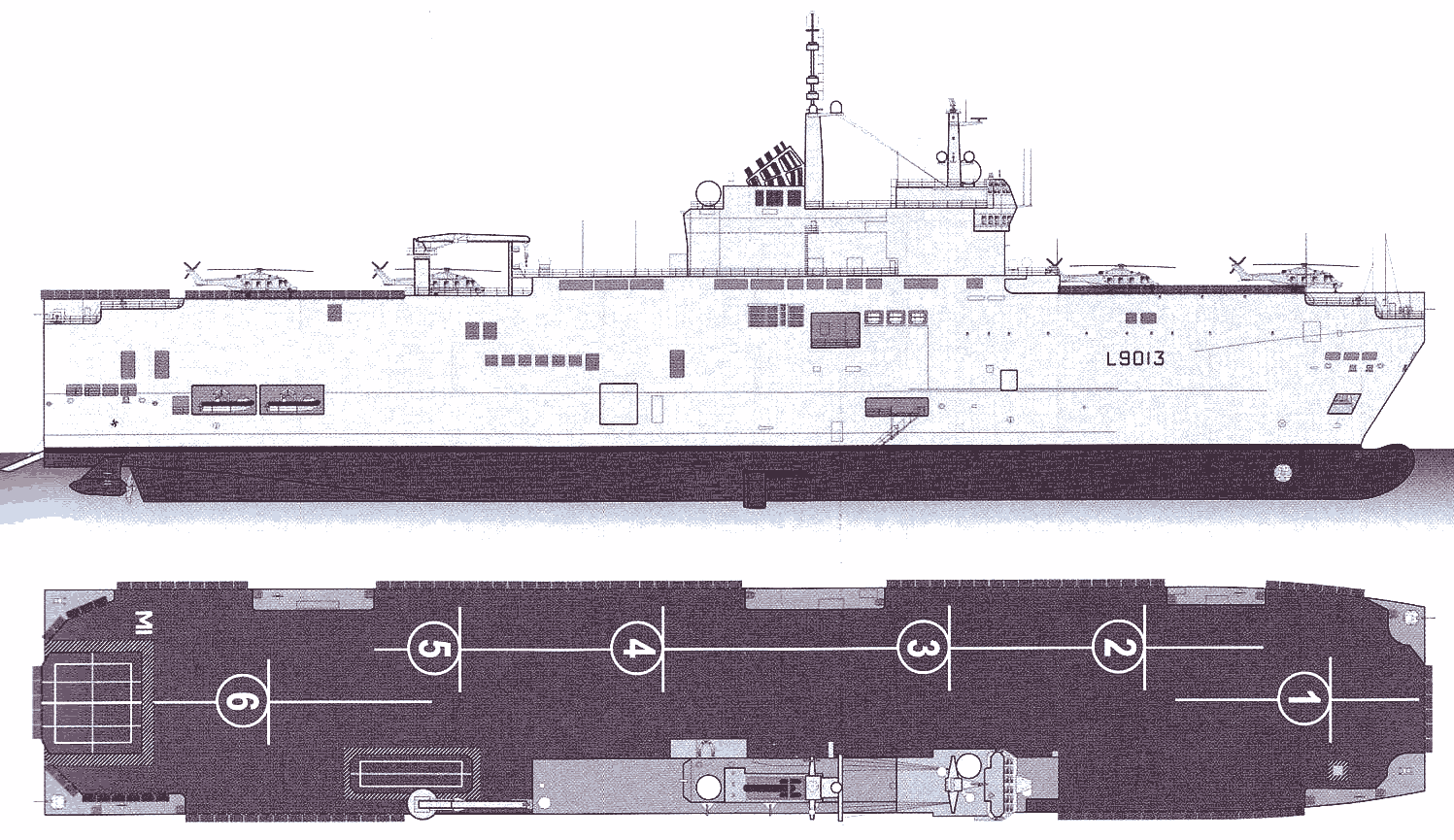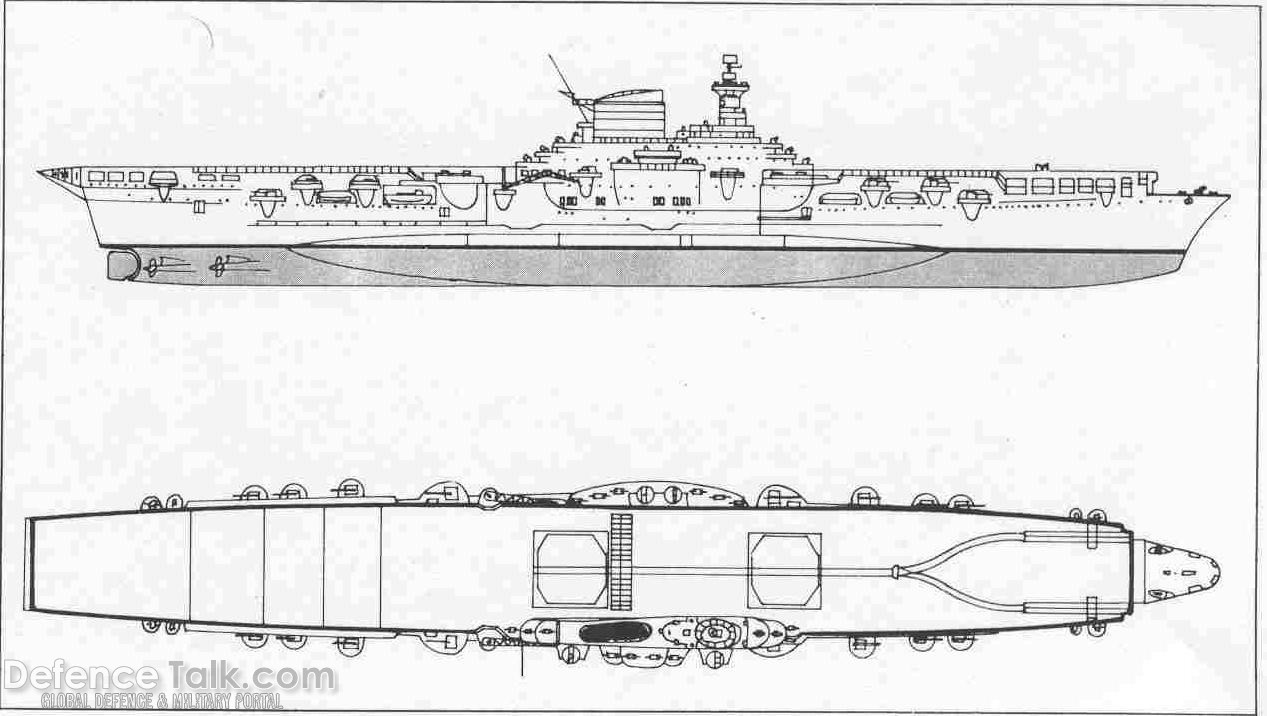Italian Aircraft Carrier Aquila - With the end of the war in August 1945, the warship finally stood up in 1946 and was transferred to La Spezia in 1949. There, she was scrapped in 1952, and the story of Italy's first aircraft carrier ended with a rather bland ending.
kts = knots | mph = miles-per-hour | nm = nautical miles | mi = miles | km = kilometers1 kts = 1.15 mph | 1 nm = 1.15 mi | 1 nm = 1.85 km
Italian Aircraft Carrier Aquila

The converted vessel of conventional design and propulsion displaces 24,000 tons under standard load and reaches 28,200 tons under full load. It has a barrel length of 772.7 feet from bow to stern, a beam of 98.4 feet and a draft of 23.10 feet.
The Armor
Self-defense armament consists of 8 x 5.3" (135 mm)/45 caliber main guns and 12 x 2.56" (65 mm)/64 caliber secondary guns. Up to 132 x 20 mm/65 caliber anti-aircraft guns (AA) are planned as the last line of defense.
Initially, Aircraft carriers were a heavily debated topic in the Italian Navy. Mussolini didn’t see much point in building carriers as he was expecting conflicts to mostly happen in the Mediterranean, close enough for land-based aircraft to strike.
However, shortly after Italy entered World War II, plans were made to convert the aging liner into an auxiliary aircraft carrier. After multiple defeats and with the Raid on Taranto to rub salt on the wounds, it was decided to go for a much more ambitious plan.
SS Roma would undergo a full conversion into a fleet carrier and the ship was renamed Aquila as the battleship Roma was under construction at the time. While Aquila might appear as a not particularly appetizing ship due to her planes having the lowest HP pool of all tier VIII aircraft, let me tell you that there is a bit more than meets the eye.

Final Opinion
The armor protection of Aquila is about as tough as lasagna pasta, especially when it comes to the citadel that, on top of that, sits high above the waterline. If you get spotted and there are battleships in range, you can start praying.
The torpedo bombers of Aquila can almost be summarized as the budget version of those on Shokaku. Each attack run is done by two planes at a time and the spread is very tight. The torpedoes also have high damage per hit and one of the highest flooding chances for airborne torpedoes.
While these torpedo bombers lack the squadron size or the survivability of those of Shokaku, they compensate by the size of the reserves, the restoration speed as well as the speed of the planes, allowing you to quickly cycle squadrons.
Another gimmick that they have is their capacity to make full turn while being on attack mode. For those who played Franklin D. Roosevelt, it's the same thing. This is particularly useful when you need to strike a ship by surprise while its hiding behind an island.
Aquila Story
Overall, Aquila ends up being a decent premium. While she suffers from fragile planes that will not forgive you for a poor target selection, her damage output is quite good, may it be by T-posing light cruisers with rockets or getting solid drops with the torpedo bombers.
Like other carrier battleships of the period, the Aquila was built on the frame of an existing ship, in this case the transatlantic passenger liner SS Roma. This has proven to be a sensible and cost-effective measure to bring the vessel into service in the shortest possible time.

In World of Warships, Aquila appears as she would have been completed. She carries fast planes with either torpedoes dealing high damage and with high flooding chances or large numbers of AP rockets with low damage per unit.
Aquila (Italian for "Eagle") was an Italian aircraft carrier converted from the trans-Atlantic passenger liner SS Roma. During World War II, Work on Aquila began in late 1941 at the Ansaldo shipyard in Genoa and continued for the next two years.
With the signing of the Italian armistice on 8 September 1943, however, all work was halted and the vessel remained unfinished. Aquila was eventually scrapped in 1952. To begin with, the ship has high reserves as well as a short restoration time.
It isn't Kaga or Enterprise level of forgiveness but combined with pre-dropping and smart target selection, Aquila will be able to handle even tier X matchmaking. Another thing to keep in mind is that both the Attack aircraft and the Torpedo bombers are some of the fastest planes at this tier.
This not only reduces the time you will spend inside of the AA range of enemy ships but will lead to short downtimes between strikes. No matter what though, managing the reserves carefully and determining what target to go for will be vital and don’t make me start talking about dodging flaks.
There were 1,420 personnel on board, including 107 officers. Armor protection includes 3.1 inches on deck. A maximum of 50 to 60 fighter jets can be carried on board - although 35 to 45 is considered more realistic due to the expected smaller hangar space during the conversion.

The Attack aircraft of Aquila are very unique in terms of behavior. Firstly, compared to other AP rockets, those of Aquila are able to slap destroyers pretty hard thanks to the low arming threshold and short fuse time.
Obviously, due to the attack distance, the destroyer needs to be spotted in advance but when the guy is lit, you can easily get 4 or 5k damage per drop. Both the Kingdom of Italy and Germany neglected aircraft carriers in their respective navies at the time - resulting in a serious lack of firepower at sea.
The Aquila is the first and only aircraft carrier type considered/handled by the Italian government. Sadly, as she was approaching completion, things would meet an abrupt end as Italy surrendered to the Allies on the 8th of September 1943. German forces took control of the ship and she was damaged in June 1944 by Allied bombings on Genoa.
To prevent her from being used as a blockship, a commando frogman unit was sent by the Italians to scuttle the ship on a safe location in April 1945. The ship is also saved from being completely forgettable by the high speed of her planes as well as her strong reserves.
In the end, in my opinion, she is more than fine for random battles but definitely not as your first carrier. The Aquila was never launched, and her construction was not complete enough to be considered worthy of a fight.
Some basic static tests were carried out on her in 1943, but with the surrender of Italy on September 8, 1943, progress came to a complete halt. The Germans then moved into the occupation hull, so the ship became a prime target for Allied aerial bombardment.

It was damaged by aerial bombs when the Allies attacked Genoa on June 16, 1944. To further limit her value, Italian "frogmen" loyal to the new government attacked the ship on April 19, 1945, partially sinking it.
For the Italian Navy in World War II, battleships remained the core of their power projection in the Mediterranean, while major powers such as the United States and Britain relied heavily on aircraft carriers to power it, Fight the enemy wherever it is.
Italy's first aircraft carrier project only took place in 1941, when the war was in full swing. Installed power comes from 8 boiler units feeding 4 stern shafts for 4 geared steam turbines rated at 151,000 hp.
This gives the ship a top speed (under ideal conditions) of 30 knots and a range of up to 6,300 miles. These specs suggest a well-behaved ship for the Mediterranean theater. Generally speaking, the Torpedo bombers will be your main loadout.
Thanks to their tight spread and the agility of the planes, they will be very effective against both battleships and cruisers. If you feel extra confident, you can even go for destroyers with them. The Attack aircraft are rather niche as they are mainly designed to deal with thinly armored cruisers or, if it's possible, destroyers.
Aquila will be available starting from the 22nd of July in the Armory for a minimum of 12,300 doubloons or in the Premium Shop for a minimum of €40.46. Is she worth it? Are her squishy planes able to pull their own weight in battle?
Here is my opinion. Due to the origin of the hull, her armor protection was particularly thin with, at best, 80 mm platings protecting the magazines and fuel tanks. A layer of up to 8 cm of concrete was also added to the bulges to work as splinter protection.
The machinery was completely replaced and went from 36,000 horsepower to 151,000 horsepower. Her old engines were replaced by those of the Capitani Romani class ships Cornelio Silla and Paolo Emilio, both under construction at the time.
The hull was also lengthened to take advantage of the stronger engines. In total, she was planned to be able to carry 51 aircraft. Due to Aquila lacking any sort of long-range AA, she is fairly vulnerable to enemy planes.
If there is a CV that wants you dead, especially with the lack of armor, it will not go well for you. Other than that, they are heavily focused on dealing with thinly protected light cruisers as the penetration is nowhere near sufficient to get citadels on anything bigger.
Thankfully, you aren't completely naked against larger ships. Due to the large number of ordinances that get launched at the target, you will still get big chunks of damage out of pure penetration damage.
aquila class carrier, sparviero aircraft carrier, aquila world of warships, italian aircraft carrier designs, italy aircraft carrier, italian aircraft ww2, italian ww2 aircraft carrier, italian carrier ww2
